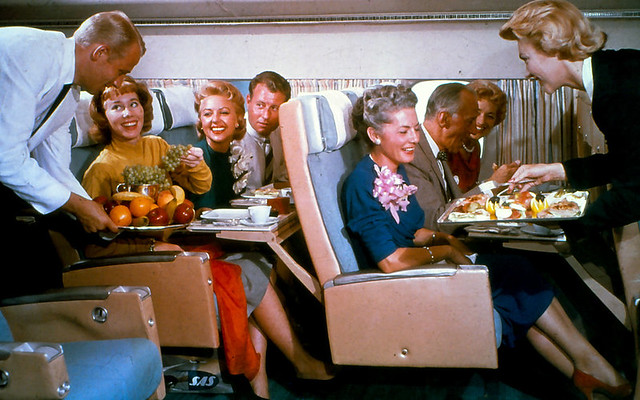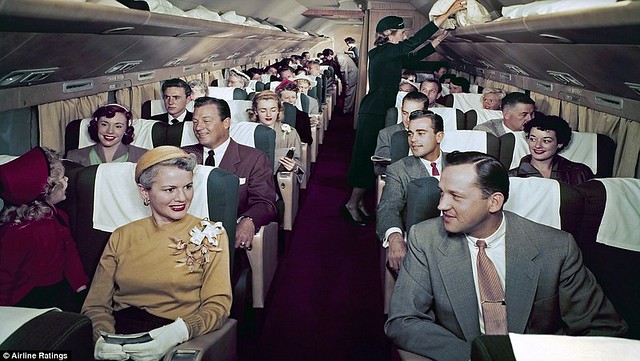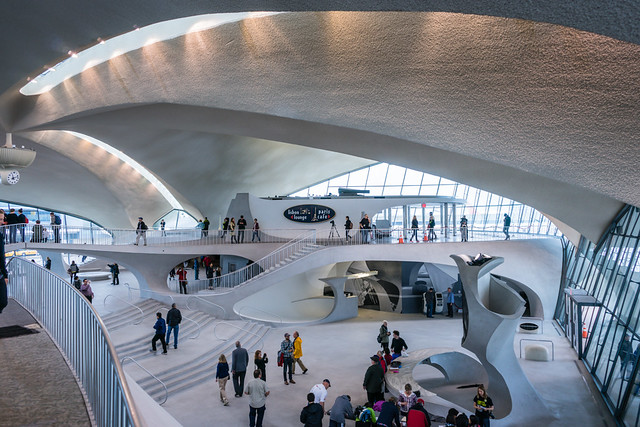
Let’s talk about the golden age of air travel.
… those good old days, maybe, are more mythical than we admit. Do you really want to travel like people did in the 1960s? Are you sure? No, you don’t have to love flying. But you shouldn’t take it for granted, either.
The author, an airline pilot who writes about commercial aviation for the New York Times, says the golden age is a myth. His arguments read like airline industry talking points:
- Air travel is cheaper than ever
- Flights are plentiful
- There are fewer stopovers on many routes
- Airplanes are better, quieter, more economical
- People used to smoke in the cabin
- Legroom hasn’t really shrunk that much
- Seat backs often feature personal video screens
- Safety is better than ever
I can’t argue with most of that. Air travel is undeniably cheaper. There are more, and more frequent flights between airports at home and around the world. Aircraft themselves are better: lighter, less polluting, more economical. Smoking is no longer allowed, a huge improvement in passenger comfort. Safety? Accident rates are at historical lows.
Fewer stopovers, though? Depends on where you’re going. I can fly nonstop from Tucson to Las Vegas or San Diego or Los Angeles. But if I want to go to Sacramento I’ll have to change planes in San Diego or Oakland. A company I used to work for flew me regularly between Tucson and Fayetteville: I had to stop and change planes twice each way, in Dallas/Ft Worth and Atlanta. I doubt things are different today.
Legroom? In 1985, economy class seat pitch on different United Airlines aircraft varied from 32 to 36 inches. Legroom across the UA fleet today is 30 to 31 inches. That’s a big deal, especially if you’re tall. And what about seat width? Our industry spokesman doesn’t mention that at all. Again using UA as a guide, in 1985 its economy class seats were 19.5 to 20 inches wide. Today they’re 17 to 18.3 inches wide. Considering that American hips, on average, are about 20 inches wide, that’s quite a squeeze.

Also not mentioned: even if you book with a major air carrier—United, Delta, American—you’re likely to wind up on a small commuter plane: more than 60% of United, Delta, and American domestic flights are subcontracted out to regional carriers operating aircraft with narrow cabins, reduced headroom, and tiny overhead luggage bins.
Unaccountably, the airline pilot who writes that there was no golden age of air travel leaves out the impact of deregulation. Before 1978, airlines were regulated as a public utility by the Federal Aviation Administration. The FAA set ticket prices and the number and frequency of flights between cities. The FAA, for example, would set the number of daily flights between Washington DC and New York City, then assign those flights to various carriers. On less-traveled routes, say Missoula to Great Falls, the FAA would set a lower number, perhaps just one flight every other day. If the carriers filled those seats, fine. If they didn’t, they’d be compensated by the government—either way, the flights would go, empty or full.
I remember flying in the days before deregulation, as do many my age. There might be 80 to 100 passengers on a 140-seat 707, and quite often the seat next to you would be empty. Today it’s a major stroke of luck to sit in a row with an empty middle seat. With deregulation, airlines are perfecting the art of stuffing planes: US airline load factors increased from 67% in 1985 to 83% in 2013, and overbooking to achieve full loading is now standard practice. Today, if your flight isn’t full the airline might cancel it at the last minute, leaving you stranded.
Going back to the 1950s, I remember flying to and from Germany on Lockheed Constellations. No way my family could have afforded those tickets, but we were on military travel orders and Uncle Sam footed the bill (I’ll wager most middle-class flyers, then and now, fly on their employer’s dime). They served breakfast, lunch, and dinner. Stewardesses would round up all the kids and take us up front to the cockpit. It was a magnificent adventure!
There was no TSA. There was no security to speak of, even though people have been setting off terrorist-style bombs on airliners, killing everyone on board, since 1933.
We didn’t know any better—actually there was nothing better—so we didn’t mind a 15-hour flight with intermediate refueling stops in Gander and Shannon. Most adults smoked in those days, and none of us kids thought anything of it (my own dad smoked at home and in the car, and I’m ashamed to say when it was my turn I subjected my non-smoking wife and young children to more of the same). I can still remember the loud drone of those mighty engines, the constant vibration of pistons and propellers, the blue flames coming from the exhaust stacks. As a kid, all that was exciting. For the adults, it must have been something to endure, but once again, in the days before jet travel, there was nothing better to compare it to.

The golden age of air travel is a myth? The hell you say. The golden age of air travel dawned after WWII with the widespread introduction of pressurized airliners that could fly above the weather and turbulent air closer to the surface, flourished under FAA control, and ended in October 1978 when the Carter administration deregulated the industry. The high points of the golden age—no invasive security checks, comfortable seating, inflight meal service, less crowding and the possibility of sitting next to an empty seat—undeniably existed, and are now gone.
Arguing for FAA re-regulation of routes and fares is a non-starter, especially with a Republican administration hell-bent on privatizing one of the FAA’s remaining core missions, air traffic control, so I won’t waste any time on that. What I do know is that stuffing more passengers into ever-smaller seats started with deregulation. I fear that when air traffic control is privatized, the airlines will start to optimize routes and schedules on some kind of “last-minute/just-in-time” business model, and that this will result in increased passenger crowding, discomfort, and misery. As for its effects on safety, we’ll have to see.
Curiously, the passengers acting out against overcrowding, slow boarding, limited luggage storage, and smaller seats are of the post-deregulation generations, rarely the old heads who remember better days. We veterans of the golden age suck it up, resignedly acknowledging that while the arc of history is long, it bends toward the lowest common denominator.
Links:
Nice column! In 1964, I flew to New York on TWA. Serious meal service, comfy seats, very exciting for my first plane ride. These days, if I never get on a plane again it will be too soon. Unless, of course, the plane is going to Hawaii. Principles be damned, it’s Hawaii.